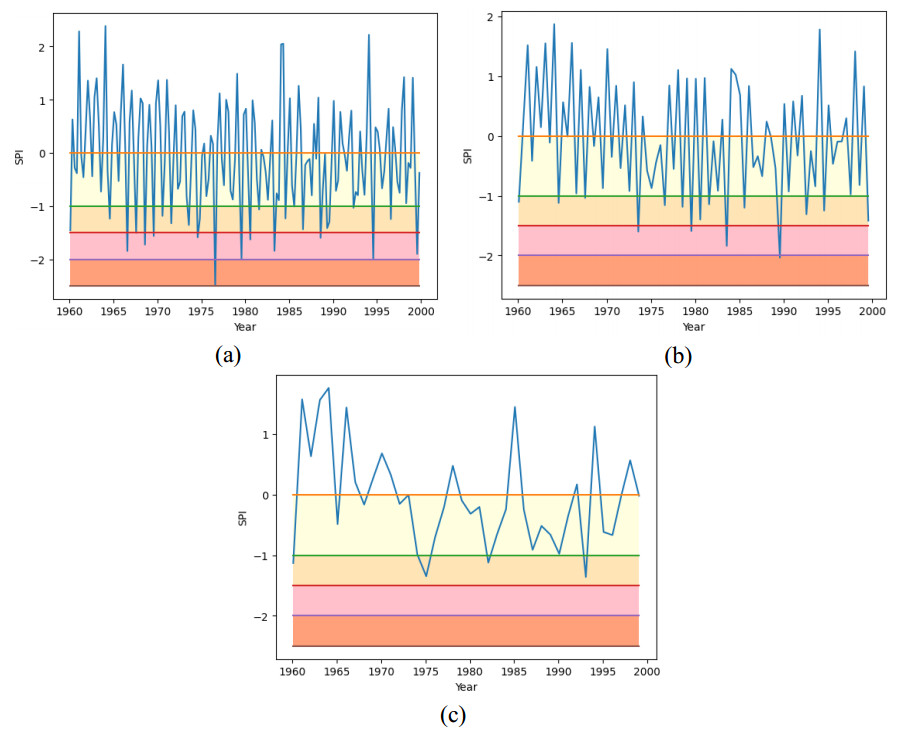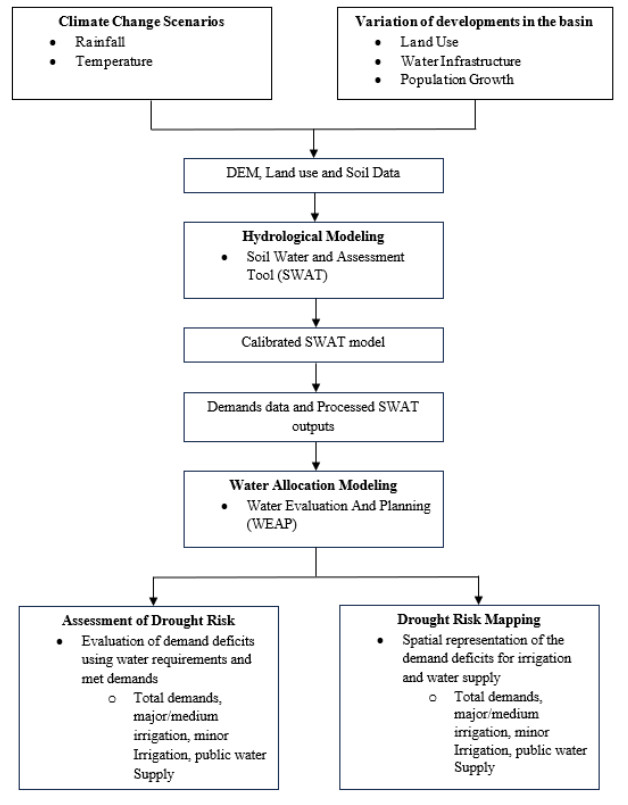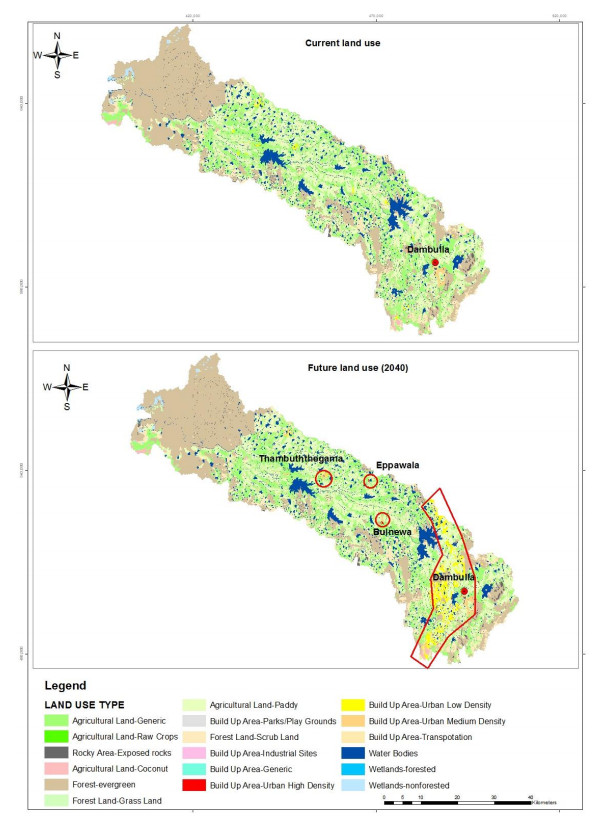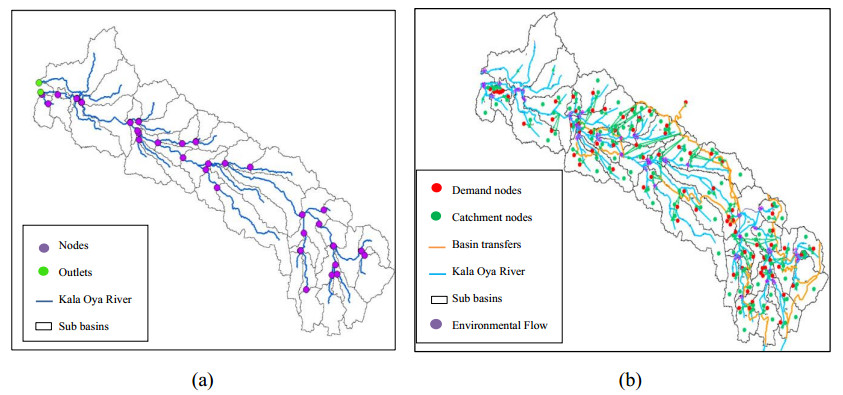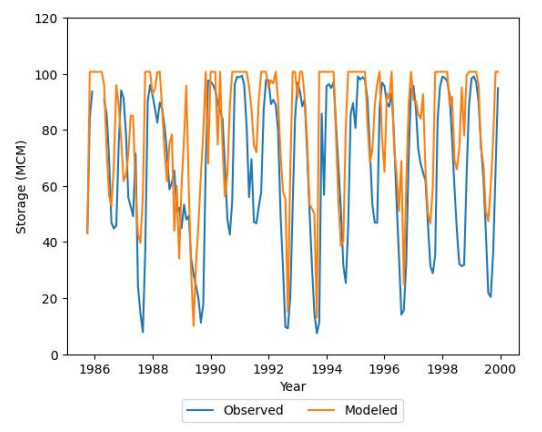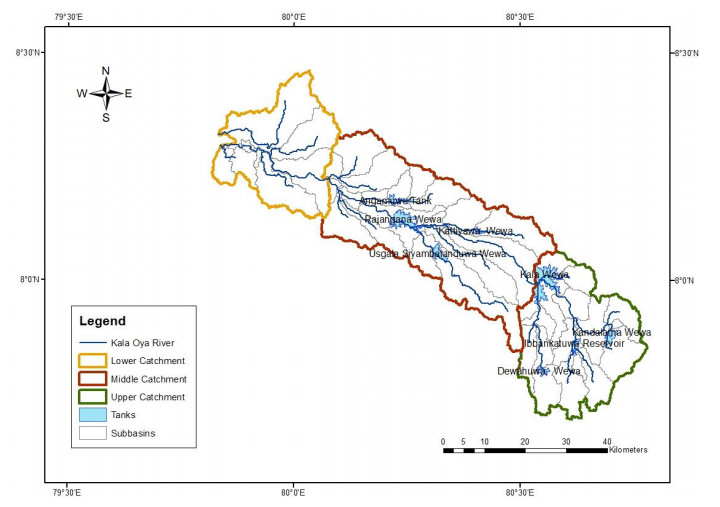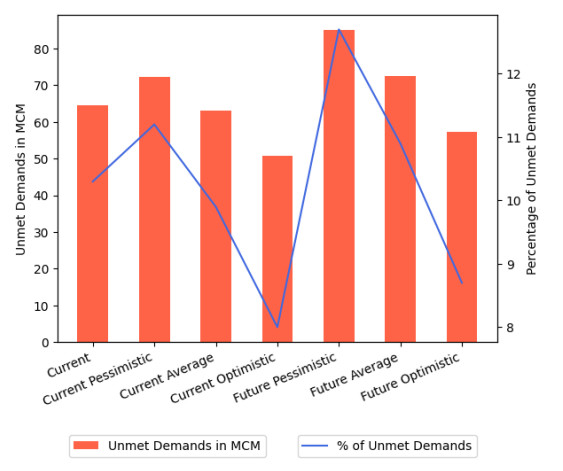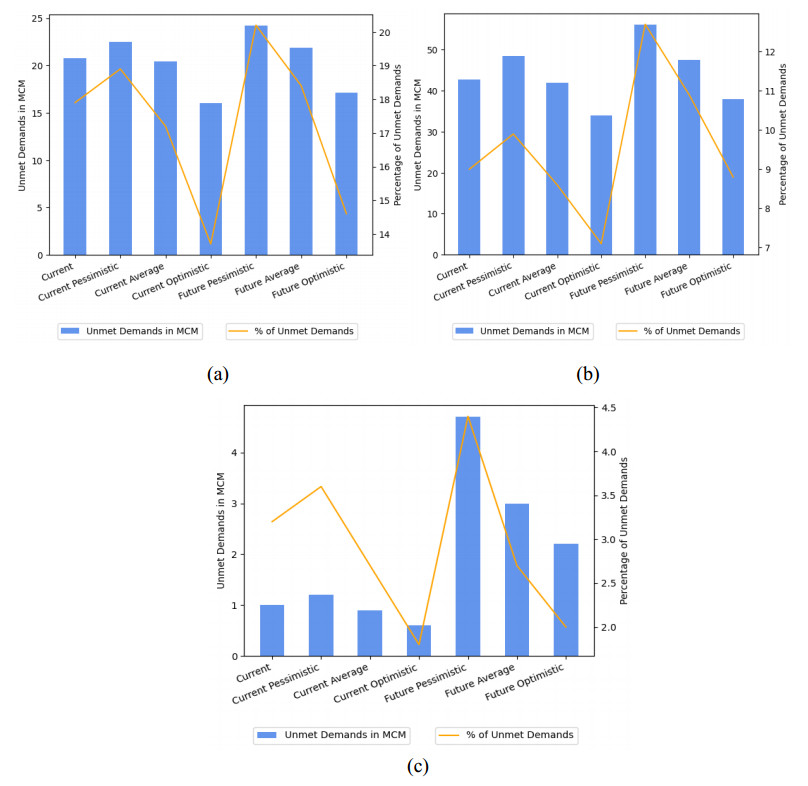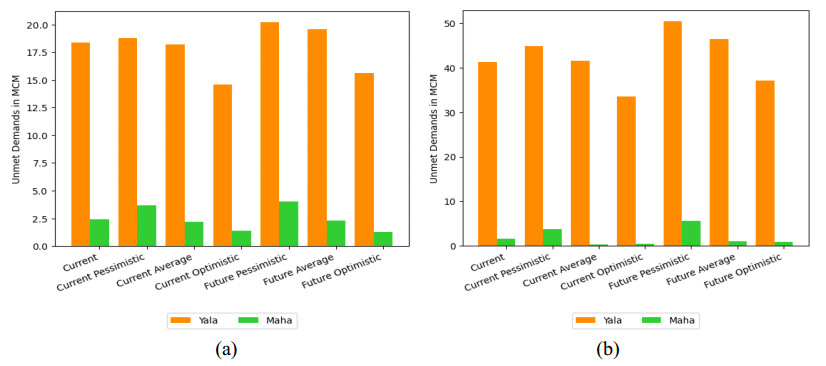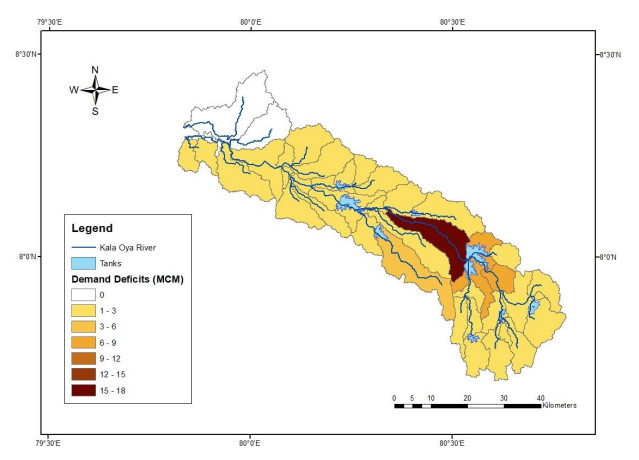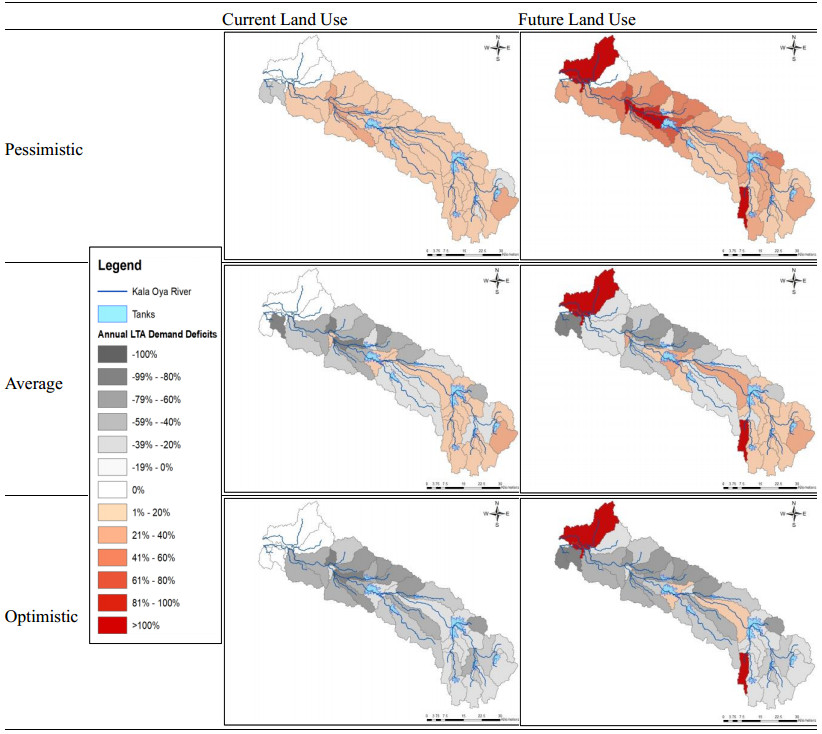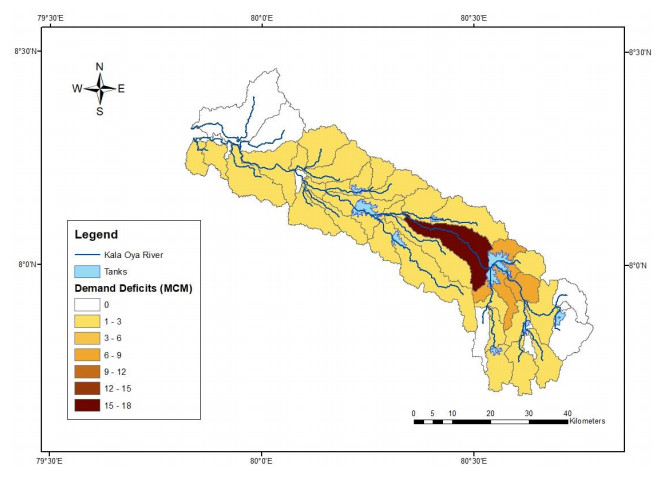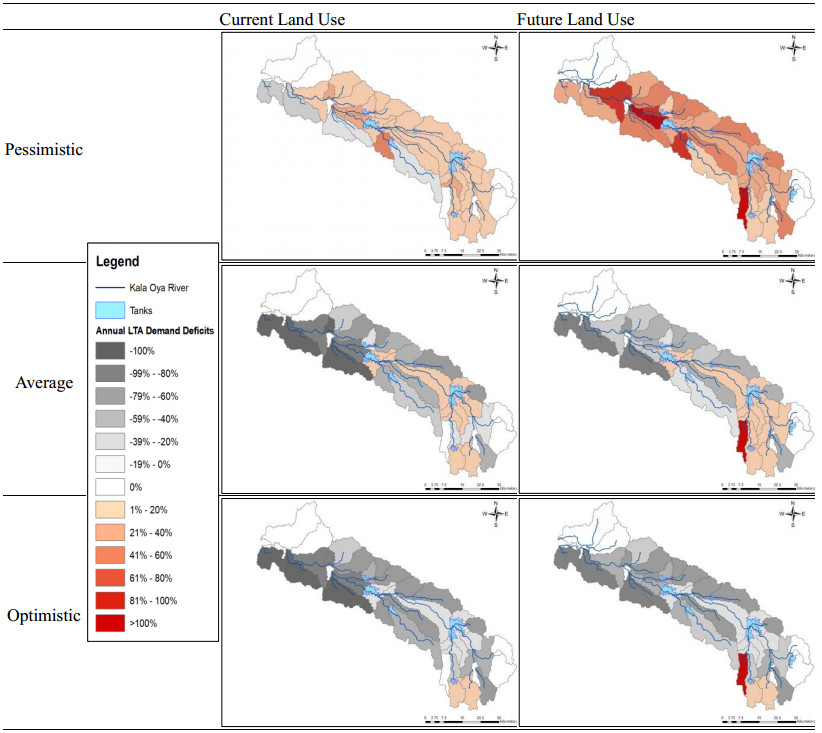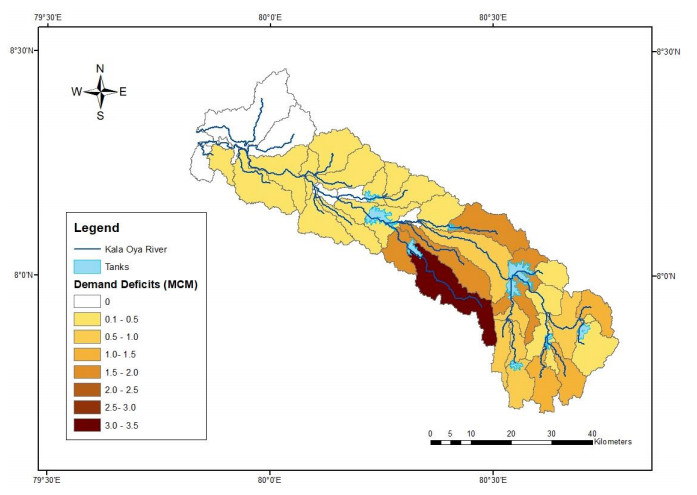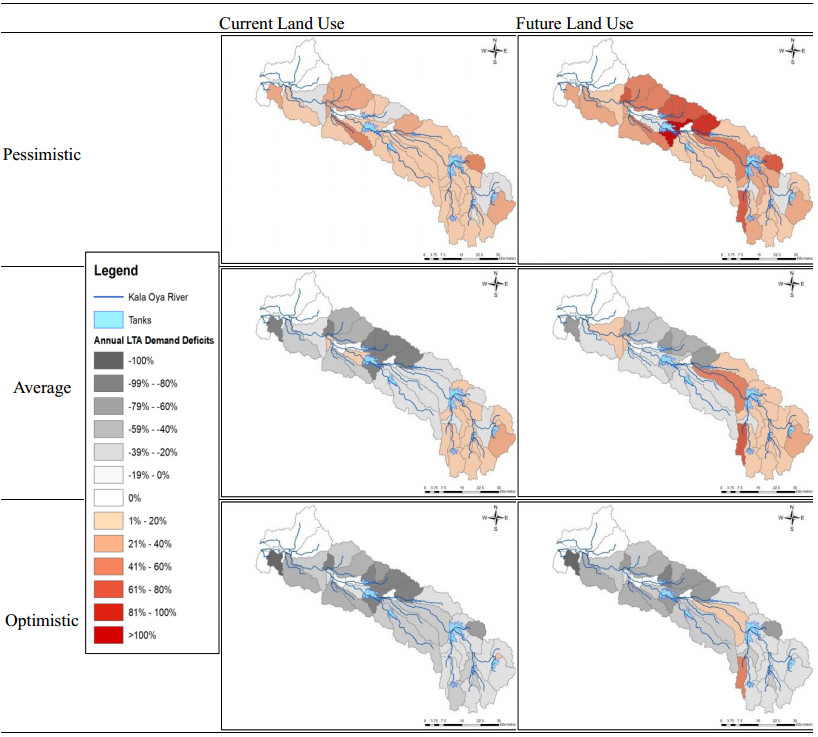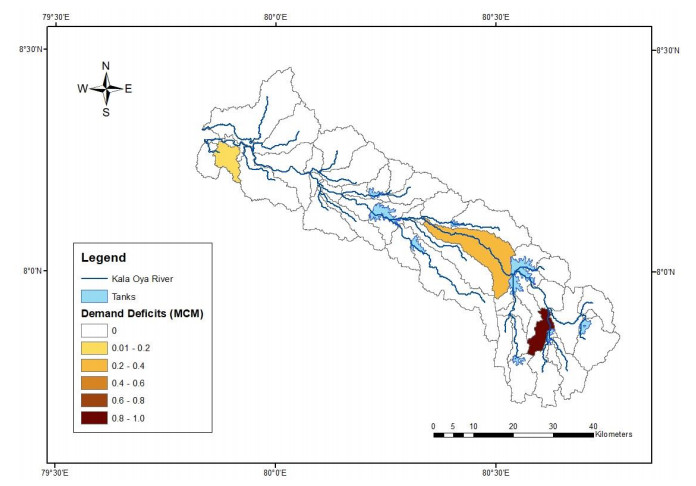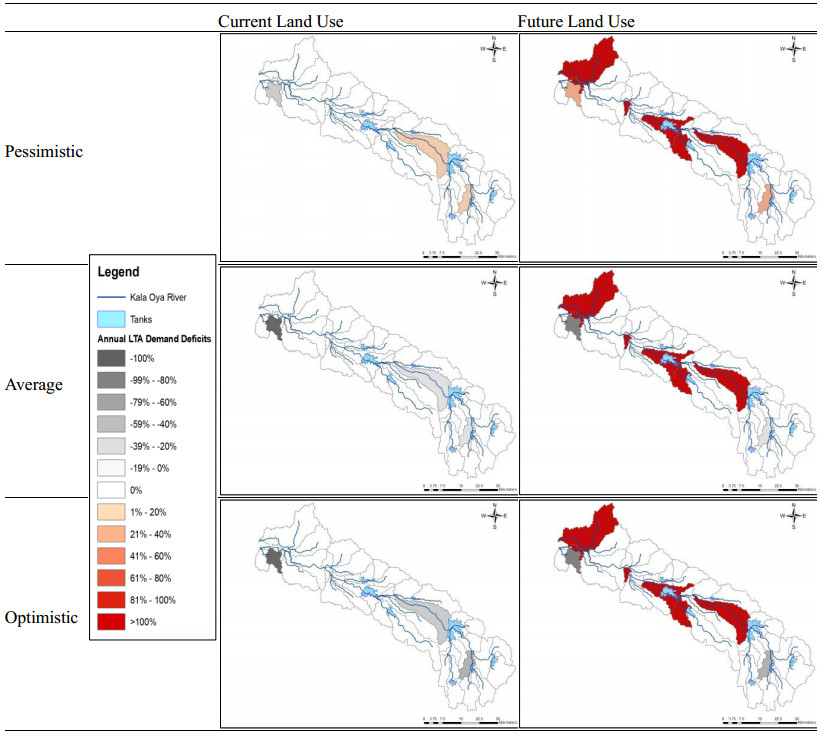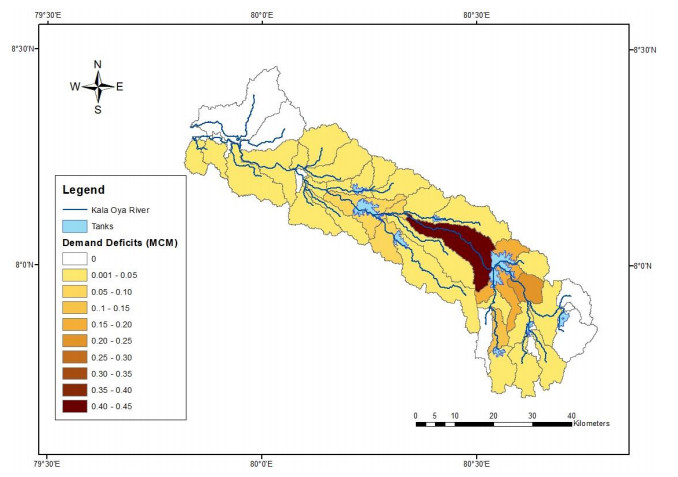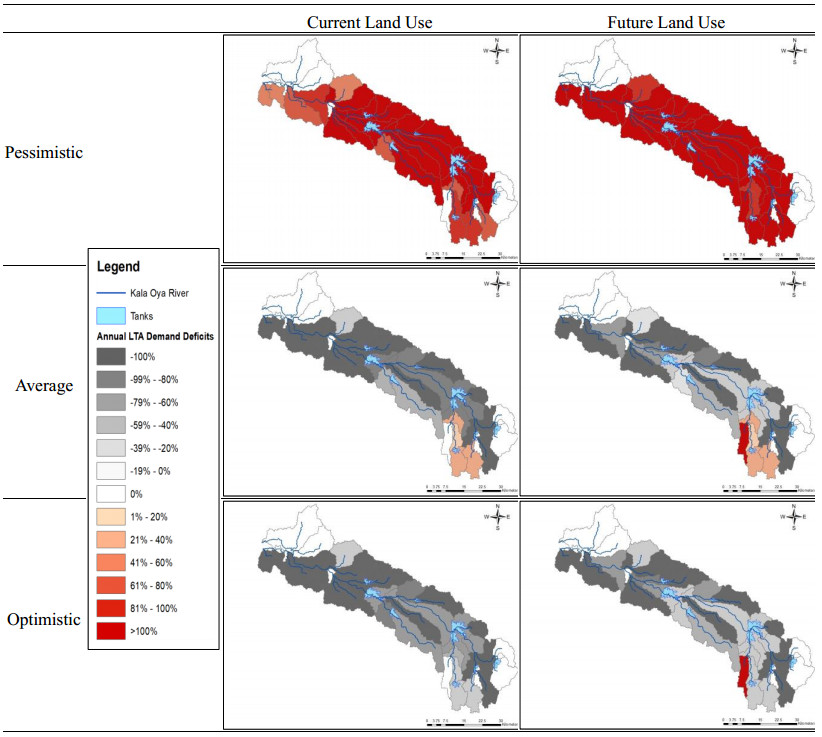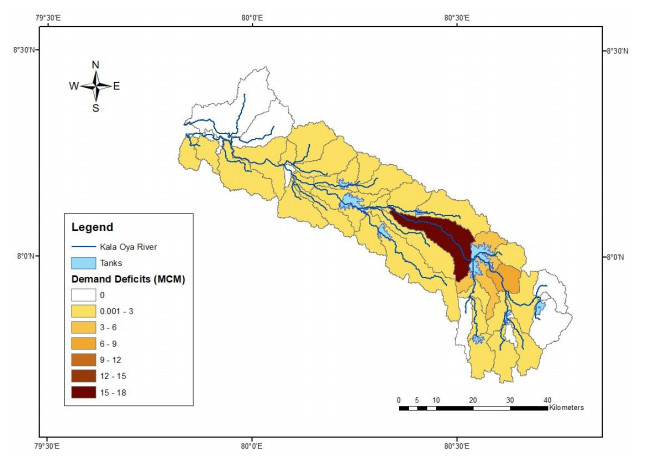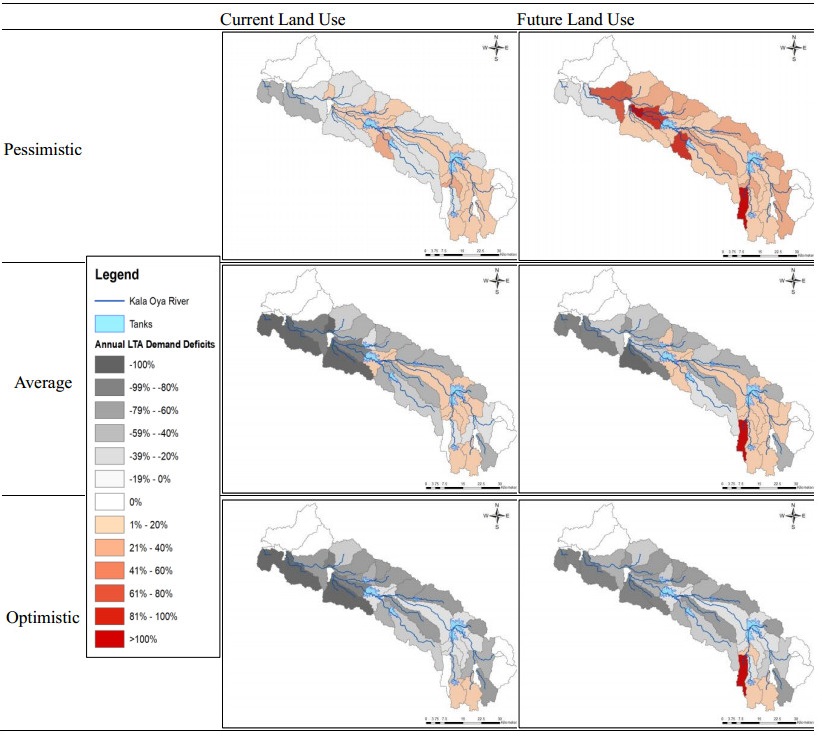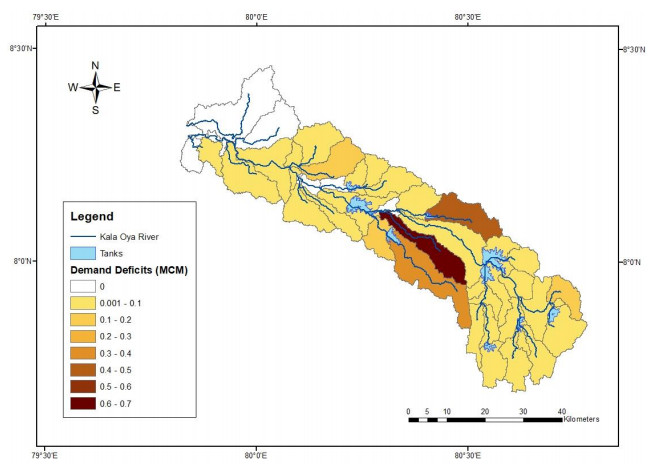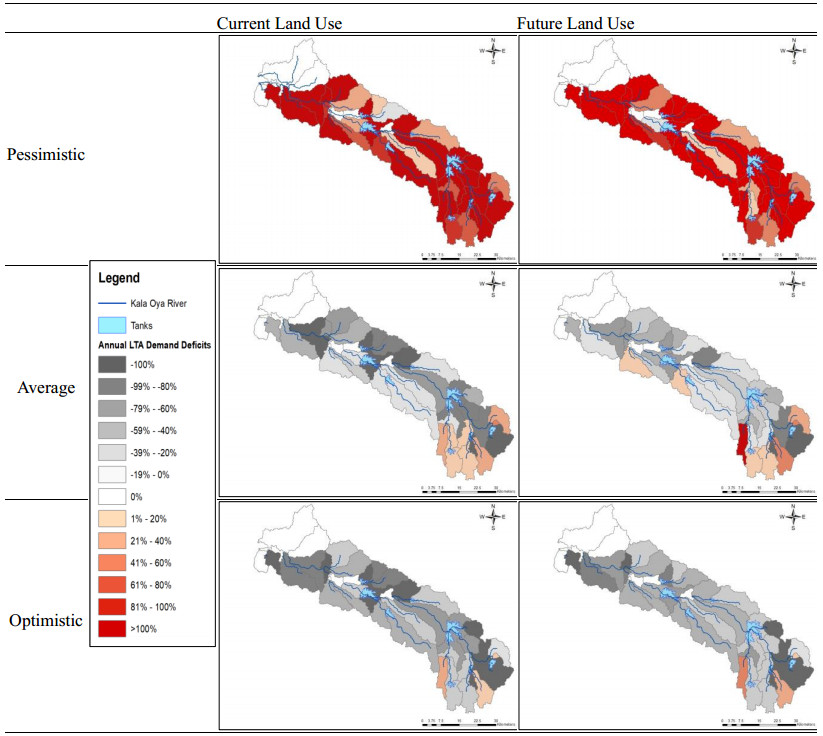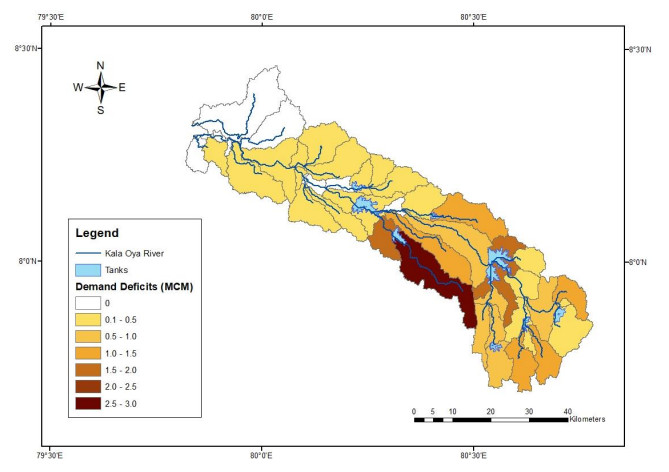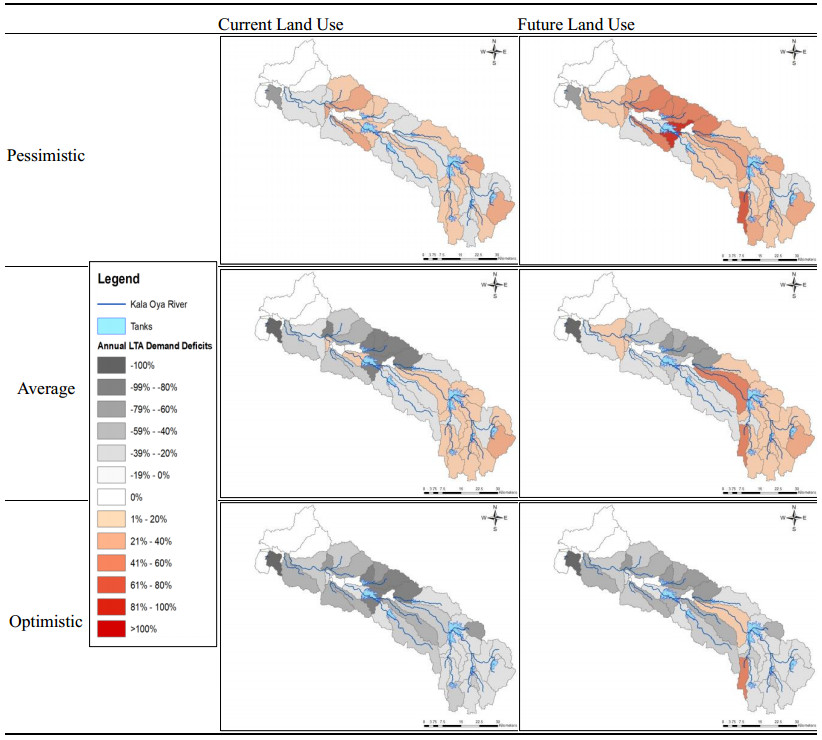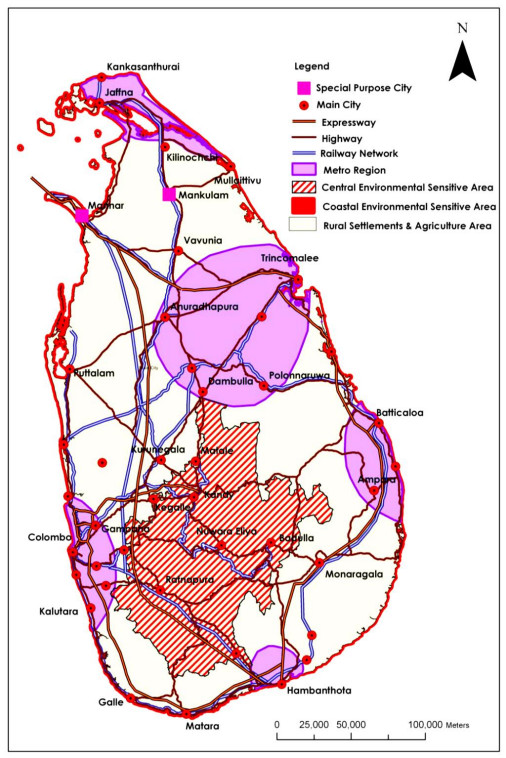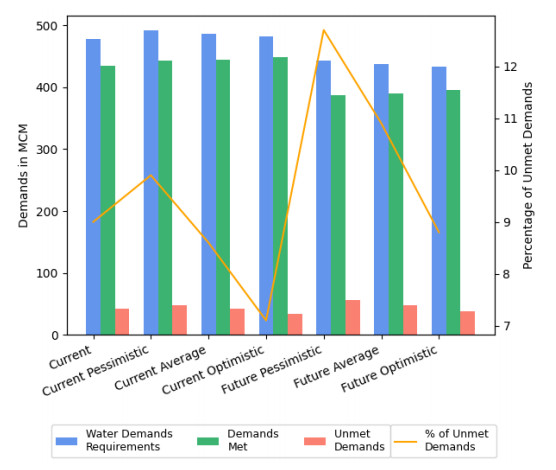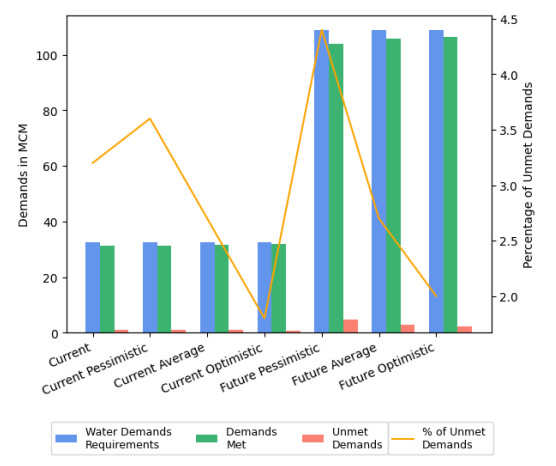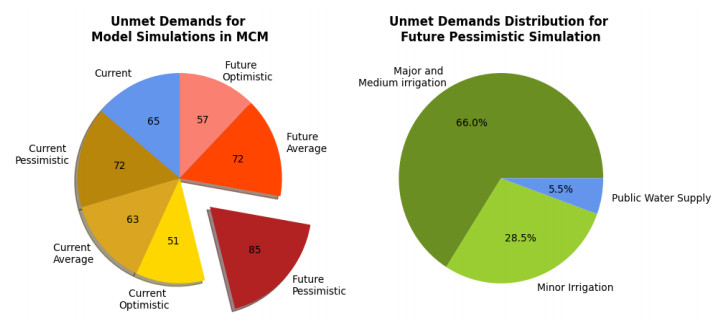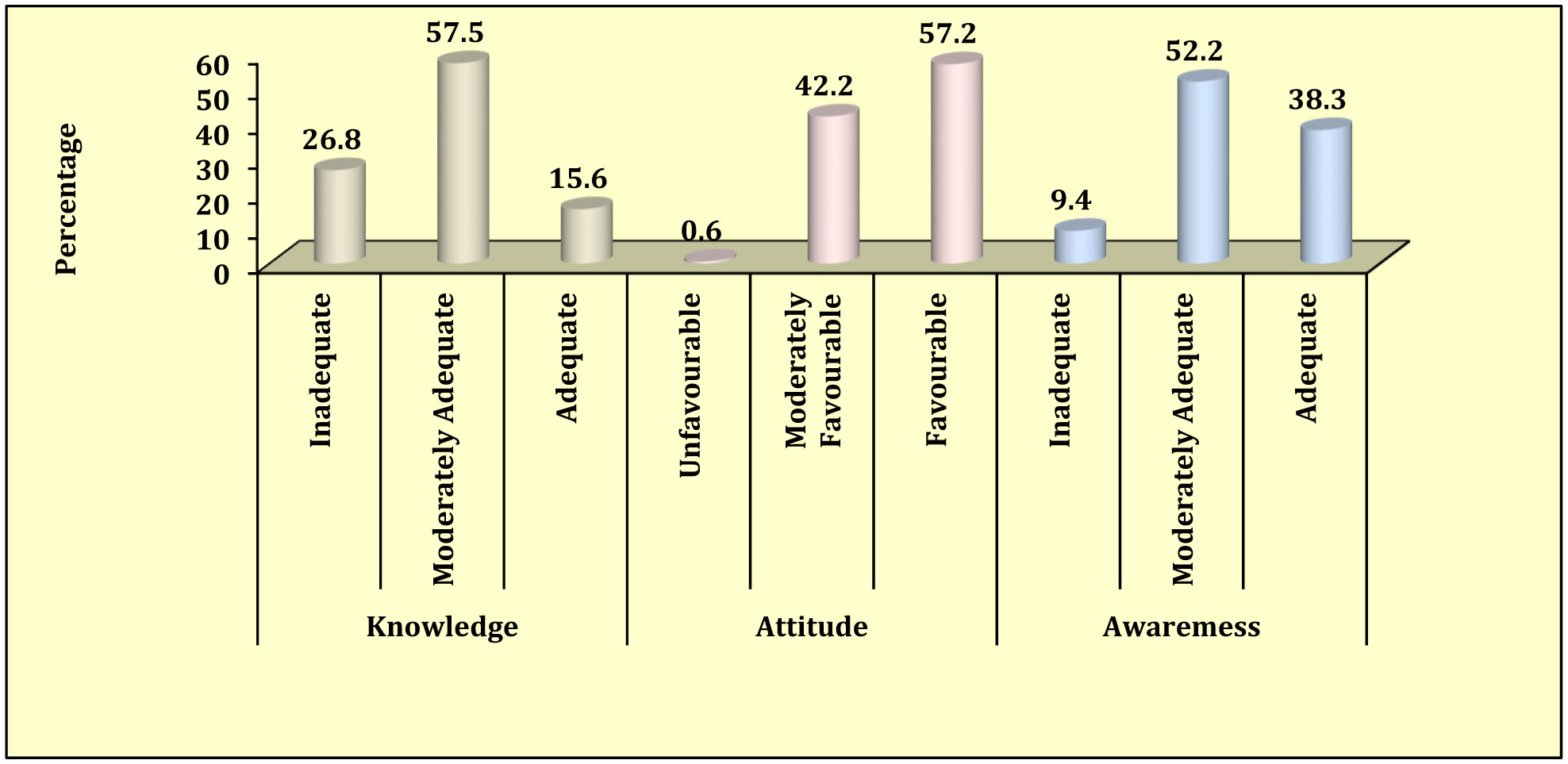1.
Introduction
Water is an essential requirement for the existence of humankind, flora, and fauna. It is identified as the key factor in managing risks such as scarcity of human needs, migration, epidemics, inequalities, and political instability [1]. Water scarcity can fluctuate depending on the equilibrium between water demand and supply. Once water demand exceeds supply due to the rapid increase in population, the development of industries, urbanization, changes of agricultural patterns, industrial pollution and climate change, water scarcity problems will arise worldwide. A total of 2.3 billion humans lives in countries with water stress, among which 733 million people live in highly and critically water-stressed regions [2]. Almost two-thirds of the world's population experience severe water scarcity for at least one month each year and half of the world's population could be living in water-scarce areas by 2025 [3]. Climate change will occur due to anthropogenic influences, and this will affect the availability of water and food security, considering crop losses in agriculture [4,5,6]. Based on the Intergovernmental Panel on Climate Change (IPCC) Sixth Assessment Report (AR6), the projected global temperature increases by 2081–2100, 1.4℃, 2.7℃, and 4.4℃ above pre-industrial levels [4]. It is driving a significant rise in both frequency and intensity of extreme weather which poses significant risk to management of agriculture and water resources. Human activities like deforestation and industrialization will further intensify the effects of climate change and raise the occurrence of disasters [7]. Natural disasters such as floods and droughts have widespread impacts, affecting groundwater, water surface availability, water quality, and agriculture productivity. Drought intensifies water shortages, reduces crop yields, and adversely affect irrigation systems, whereas floods can devastate crops and disrupt supply chains and water management infrastructure. Apart from these extreme events, shifts in meteorological conditions are projected to trigger cascading effects on water and soil systems. Intensified precipitation extremes will cause rapid surges in streamflow, increasing flood hazards and straining flood control measures. This will accelerate soil erosion, deplete essential nutrients, and contribute to sediment buildup in waterways. Additionally, excessive rainfall will lead to waterlogging, which deteriorates soil structure and threatens crop productivity. Sri Lanka is a tropical country in the South Asia region with a monsoonal climate. The country receives rainfall mainly from strong monsoons generated in the Indian Ocean and cyclone depressions created in the Bay of Bengal [8]. Sri Lanka experiences two major monsoon seasons: The southwest monsoon season from May to September and the northeast monsoon season from December to February [9,10,11]. The country has three climatic zones, namely wet, dry, and intermediate zones with respect to the rainfall received in the year. Due to this seasonal variability, agriculture is practiced where paddy is grown as the major crop [9]. Crops are grown mainly in two seasons, which are the Yala and Maha cultivational seasons [12]. Nevertheless, seasonal crop failures were visible for several years in the period 2001-2018 in the dry zone because of drought [13,14].
Kala Oya basin is mainly in the dry zone (97%), and a small area (3%) lies in the intermediate zone. Ancient kings constructed reservoirs in dry zones to utilize water for agriculture during dry periods [15]. The economy and settlements were based on these reservoirs, so it developed as a hydraulic civilization. The river basin consists of major, medium, and minor tanks as cascade systems. Tank cascade systems are situated at higher altitudes of the entire set of tanks. The Kala Oya basin was subjected to population rise due to urbanization [16]. This will cause significant changes to land use and allocation of water for demands.
Soil Water Assessment Tool (SWAT) and Water Evaluation and Planning System (WEAP) are two software applications used for hydrologic studies all over the world. SWAT was utilized in water resources assessment [17], hydrological [18,19] and ecohydrological modeling [20], flood [21,22], drought [23], comparison of hydrological models [24], and climate change assessments [25] projects. Further, SWAT was used to represent the agricultural conservation practices [26] and impact of land use change on hydrology [27,28], evaluating remote sensing datasets [29] and assessing long term climate trends [30]. WEAP was used in water planning [31], management [32] and evaluating the water demands in the context of climate change [33,34,35,36,37,38,39,40,41].
SWAT and WEAP have been used in numerous international studies. The researchers in [34] coupled SWAT-MODFLOW, which was used for surface-subsurface hydrological modeling, and WEAP was used to assess unmet demands of public water supply in the river Dee catchment, Wales by means of the UKCP18 climate model. The researchers in [39] used SWAT for hydrological modeling and WEAP for water demand analysis in the upper Pangani river basin, Tanzania with regard to GCMs. SWAT was used by the researchers in [41] for hydrological modeling and water demand analysis was done for Hongshui River Basin considering socio-economic (population and industrial growth and deforestation) and climate change RCP scenarios using WEAP. Kaushalya and Hemakumara [42] integrated the SWAT and WEAP models to assess the water allocation for different demand types, considering the variation of reservoir storage within the Malwathu Oya basin, Sri Lanka with respect to the climate change scenarios. Nonetheless, there is a substantial research gap in assessing the impact of climate change scenarios on the water resources of the Kala Oya River basin spatially. The impact of climate change adversely affects the water resources system of the Kala Oya basin. Climate change-induced high-intensity short-duration rainfalls [43] increase the magnitude, frequency, and severity of extreme flood events. The increment in ambient temperature [43] leads to the occurrence of prolonged drought periods which leads to water shortages within the basin. A few climate change studies were carried out for Kala Oya. A drought study was carried out by evaluating the Standard Precipitation Index (SPI) for 59 years and investigating the long-term drought in the basin [44]. Another study was done on river basin and agrarian management and policies adjusting to climate change in the northwestern part of the country [45]. A rainfall-runoff model was developed by [46] using SWAT and calibrating, validating, and comparing the streamflow with past studies.
Our objectives of this research are to:
1. Combine SWAT and WEAP models to evaluate the effect of climate change and land use on water resources in the Kala Oya basin specifically assessing for each water users (major/medium and minor irrigation and public water supply);
2. Considering the above objective, the unmet demands for each water users are to be assessed for the effect of climate change and land use (current and future) on water resources of the basin. Both graphical and spatial illustrations of annual and seasonal demand deficits will be represented.
This would be beneficial for the appropriate organizations and practitioners involved with the execution of planning and strategies for management of irrigation and water resources in the country.
2.
Study area
Kala Oya is the third largest river basin in Sri Lanka [44], which has a catchment area of 2866 km2. It is mainly in the northwestern Dry Zone of Sri Lanka within two climate zones where 97% is in the dry zone while the rest is in the intermediate zone [15]. The basin elevation varies from mean sea level to 600 m above mean sea level (MSL); most of the area is within 70–200 m and is mainly comprised of flat lands. The Kala Oya basin covers three provinces and four districts: Anuradhapura in the North Central Province, Kurunegala and Puttalam in the Northwestern Province, and Matale in the Central Province, including 21 divisional Secretary divisions. The total population in the basin is 522191 as of 2012 [47].
The basin receives rainfall from both northeast monsoon and southwest monsoon periods, but the highest rainfall occurrence is during the Maha season from October to December. The annual average rainfall is about 1500 mm but varies from 1700 mm at high elevations in the south-eastern end of the basin and gradually drops to 1200 mm towards the north-western part [48]. The annual average temperature of the Kala Oya basin is about 33℃ and the basin temperature varied from around 39℃ to 15℃ during dry and wet months respectively. It is considered one of the driest basins, facing severe water shortage issues [46] in Sri Lanka. High seasonal and spatial variations led to receiving low rainfall into the basin. The lowest occurrence of rainfall is from June to August while the highest occurrence is from October to December. Thus, the basin is affected by both flood and drought for certain periods.
The river basin consists of eight major reservoirs and more than 2000 medium and minor reservoirs. The Kala Oya basin receives significant inflows from the neighboring Mahaweli River basin through diversions and it transfers water to adjacent river basins through diversions [45,49]. The economy of the basin mainly depends on agriculture. Six major irrigation schemes, 10 medium irrigation schemes, and more than 800 small irrigation schemes operating in the Kala Oya basin covering 60000 ha of land. Although the Kala Oya basin is covered by a well-connected reservoir system, water deficiency problems arise during the dry season. The naturally available water in the dry zone has been incapable of satisfying irrigation demand in the Maha and Yala seasons [49]. Therefore, a comprehensive assessment is required to analyze the water availability of the basin for domestic industrial and irrigation water requirements. The Kala Oya location map is illustrated in Figure 1.
The past drought metrics prevailing in Kala Oya basin were evaluated by calculating the Standardized Precipitation Index (SPI) for the center of the Kala Oya basin for the baseline scenario (without the impacts of land use and climate change). The researchers, Lloyd-Hughes and Saunders [50] specified the drought classifications for each of the SPI ranges. SPI values less than −2 were classified as "extremely dry" whilst the values between 0 and −1, −1 and −1.5, and −1.5 and −2 were categorized as "mild dry", "moderately dry" and "severely dry" respectively. The drought classifications for Kala Oya basin are tabulated in Table 1. The SPI variations for 3, 6, and 12 months are illustrated in Figure 2 (a), (b), and (c), respectively.
The SPI for 3 months was classified into "severe dry" and "extreme dry" for 8% and 1% of the time, respectively. Moreover, the SPI for 6 months categorized for 4% and 1% of the time as "severe dry" and "extreme dry", respectively. Although none of the times SPI for 12 months is classified into these two categories, around 57% of the time, indices (negative) fall into dry classification. It is fascinating to evaluate the allocation of water for demands considering the droughts prevailing in the Kala Oya basin.
3.
Methodology
3.1. Modeling strategy
A comprehensive hydrological and water allocation study incorporating the impacts of land use and climate change was developed to assess the domestic and agricultural water requirements of the Kala Oya basin.
Our purpose of this study is to evaluate the water resources of the Kala Oya basin and the water allocation for the basin's demands based on meteorological data. There are no streamflow measuring stations functioning within the basin. A hydrological model was developed using Soil and Water Assessment Tool (SWAT) software, and water allocation model was developed using Water Evaluation And Planning (WEAP). The methodology of the research is represented in the following Figure 3.
Initially, seven climate change scenarios were chosen from the climate model (explained in the section 3.1.1). The basin developments incorporated along with the climate change on the hydrological model build using SWAT. The hydrological system of the Kala Oya basin was represented using the SWAT model to understand the impact of climate change on the hydrological processes of the basin. The details about the key features of the model are given in section 3.1.3. The hydrological model was processed to attain the inputs for the water allocation model built using WEAP. This was run for seven model scenarios to evaluate the drought risk in the Kala Oya basin. Drought risk was mapped spatially in terms of demand deficits for water users of irrigation and public water supply. An in-depth description of each process is clarified in the subsequent sections. The data used in this study is shown in Table 2.
3.1.1. Development of a climate model
The MarkSim weather generator, developed by Waen Associates, UK [51], utilizes statistical methods to simulate long-term weather patterns based on historical observations. This tool enables the creation of realistic datasets for various climatic conditions, aiding in the assessment of potential climate change impacts, analysis of hydrological processes, and evaluation of water resource management strategies. In this study, the MarkSim weather generator was employed to select the Global Circulation Models (GCMs) and downscale them to represent the climate of the Kala Oya basin. The statistical downscaling was conducted using the NEX-NASA Downscaling (~25 km), adopting the Bias Correction and Spatial Disaggregation (BCSD) approach for a better analysis of localized climate impacts in the Kala Oya basin.
The statistical downscaling process utilized the NEX-NASA Downscaling model (~25 km resolution) with a specific technique known as the Bias Correction and Spatial Disaggregation (BCSD) approach. This method was selected to provide a more accurate analysis of localized climate impacts within the Kala Oya basin. First, the climate model outputs were adjusted to correct systematic biases by comparing historical modeled data with observed rainfall records from 1960 to 2016. This bias correction ensures that the downscaled data accurately reflects the observed climate variability and trends. Following this correction, the data were spatially downscaled from the coarser resolution of the Global Climate Model (typically 100–300 km) to a finer grid size of 25 km, enabling a more precise representation of localized climate patterns.
IPCC has defined four Representative Concentration Pathways (RCPs), representing different future trajectories for greenhouse gas emissions. These pathways serve as input for climate models to project future climate conditions and impacts under various scenarios [4]. Specifically, RCP 6.0 and 8.5 emission scenarios, representing intermediate and high greenhouse gas emissions, respectively, were considered in this study to evaluate the diverse implications of emissions on drought risk and climatic variability in the Kala Oya basin. These scenarios were chosen to assess a broad range of possible future climate impacts on drought risk and climatic variability in the basin. RCP 6.0 provides insights into conditions under moderate mitigation efforts, whereas RCP 8.5 serves as a worst-case scenario, helping to evaluate the basin's vulnerability under extreme climate change. While worst-case scenarios are useful for identifying maximum potential risks, relying on mitigation strategies solely on them may result in excessively high implementation costs. Therefore, understanding the impacts under a moderate scenario like RCP 6.0 is crucial for developing cost-effective adaptation and mitigation strategies. This approach would help decision-makers prioritize feasible investments while broadening understating the worst case and ensuring resilience to climate change. In conclusion, the benefit of selecting these two emission scenarios in the study is that they provide insights into how the Kala Oya basin could be affected under varying levels of global emissions, thus aiding in more robust climate adaptation and mitigation planning.
The impacts of key climatic drivers such as monsoon, Madden-Julian Oscillation, Indian Ocean Dipole, El Niño, and La Niña, which significantly affect Sri Lanka's climate, were considered in the selection process of appropriate GCM/RCP combinations through defining boundary conditions to model the influence of these phenomena on the climatic variability in the Kala Oya basin.
The following GCMs were selected according to the climate model as mentioned in this section 3.1.1. This was based on a comprehensive ranking system: CSIRO-MK3-6-0, FIO-ESM, GISS-E2-H, IPSL-CM5A-MR, and MIROC5. Further details on the selected GCMs are provided in Table 3 [52].
Three future climatic scenarios were developed to assess the drought risk in the Kala Oya basin by selecting appropriate GCM/RCP combinations among 10 combinations comprised of 5 GCMs and 2 RCPs.
• The RCP6_GISS_E2_H combination is identified as the "pessimistic" scenario. Among 10 GCM/RCP combinations, RCP6_GISS_E2_H combination produced the lower rainfall totals and higher average temperatures, which generates the highest increase in drought metrics.
• Similarly, the RCP6_MIROC5 combination is identified as the "optimistic" scenario which generated higher rainfall totals and lower average temperatures among 10 combinations, resulting in the lowest increase in drought metrics.
• The RCP8.5_CSIRO_MK3_C_0 combination is identified as the "average" scenario out of 10 combinations, which produced the rainfall and temperature totals closest to the 50th percentile value, generating an average increase in drought metrics.
3.1.2. Developments in the basin
The current and future land uses (2040) were encompassed in the models of this research. These were included in this study to assess the presence and absence of the impacts of basin developments with climate change on the availability of water for the users. Current land use information has been mapped at a 1:10,000 scale as part of a national program of land use planning guided by the Land Use and Planning Policy Department (LUPPD) of the Ministry of Land and Land Development. The LUPPD of Sri Lanka is the designated government authority responsible for preparing and updating land use maps based on current and future national plans. As a result, the land use maps obtained from LUPPD incorporate proposed development characteristics and anticipated land use patterns. These maps are widely used by government institutions for decision-making. In this study, land use changes were analyzed using the LUPPD land use map. However, the SWAT model requires land use data to be formatted according to the FAO dataset, which aligns with the model's inbuilt database. To integrate the LUPPD land use classification into SWAT, these were matched with the FAO land use categories based on their characteristics and included the adjusted dataset in the model.
The developments of the Kala Oya basin comprised changes in land use, population growth and water infrastructures. The foremost variations befallen in the future land use from current land use were,
• Variation of land use class (agricultural lands to urban lands);
• Population growth (increment of settlements in land areas);
• Commercialization and industrialization of lands (rising water demands due to water infrastructures).
Using the LUPPD land use mapping, the existing land use maps were updated to represent the projected land use change in 2040. The current and future land use maps are represented in Figure 4. The future land use changes were further debated in section 5 with the model results.
3.1.3. SWAT model for Kala Oya
The Kala Oya SWAT model development was based on the Digital Elevation Model (DEM), enhanced by a defined river network and the locations of basin inlets, outlets, and existing and proposed online reservoirs. Based on the SWAT model cell resolution, and the location of the reservoirs in relation to the delineated river network, 8 online major reservoirs have been modelled in SWAT. The diversions into the basin and diversions from the basin were also incorporated into the SWAT model as inlets and outlets. The SWAT model of the Kala Oya basin was schematized to cover the basin. The watershed and sub-basin delineation process resulted in the creation of 47 sub-basins for the Kala Oya basin.
The local land use and soil data were matched with the SWAT-specific land use and soil codes to accurately represent the basin specific land use and soil characteristics in the model. Accordingly, 297 Hydrological Response Units (HRUs) were created considering land use data, soil data and topography in the watershed. The weather data selection for the SWAT model was followed by a comprehensive hydrological data processing protocol. The gap-filled daily rainfall records at 41 rain gauge locations and gap-filled temperature records at 4 weather stations within and near the Kala Oya basin were derived for use in rainfall-runoff modeling. The rainfall and temperature series for each sub basin centroids were developed using observed data applying the Inverse Distance Weighting (IDW) method. Daily minimum and daily maximum temperature data were used as a key input to estimate Potential Evapotranspiration (PET) within the SWAT model. The Hargreaves method [53] was selected to estimate PET from the gap-filled temperature data.
3.1.4. Development of the WEAP model
The water allocation model is essential to conduct the water resources assessment. Water Evaluation and Planning (WEAP) software was used to build a water allocation model for the Kala Oya basin. The WEAP model schematized considering the spatial distribution of the demands in connection with the rivers and reservoirs. This schematization was done in a way to match it with the SWAT river network and sub-basins. Irrigation water demands in the Kala Oya basin are associated with major/medium scheme irrigation and minor scheme irrigation and are closely linked with the presence of major, medium, and minor tanks which act to provide temporary seasonal storage of surface water to meet dry season agricultural water demands and with anicuts and diversion canals to transfer water to where it is required. The diversion flows, major, medium, minor and rainfed agricultural areas and crop types were modelled in WEAP to calculate the agricultural water demand of the basin. The public water supply demands were also incorporated in the model. There are three water intakes and ten proposed water intakes in the Kala Oya basin to cater for the domestic water demand of the basin. Environmental flow requirements were also calculated and included in the WEAP model. Figure 5 (a) and (b) represent the schematized SWAT and WEAP models for the Kala Oya basin.
3.2. Model scenarios
A water allocation model in WEAP was built to evaluate the existing and future drought risk to the Kala Oya basin. This assessment was carried out in terms of the demand deficits, including the climate and land use change through the evaluation of seven model scenarios.
The analysis was supported by a rainfall-runoff model (SWAT) and water allocation model (WEAP). Daily rainfall and temperature time series of 99 individual stochastic years from 1901 to 1999 were used as climate inputs to the SWAT. These were applied at each specific rain gauge and temperature gauge location. This baseline (without climate change) and ten future daily rainfall and temperature data series (with GCM/RCP combinations) for 99 individual statistical years were used as a natural flow for the rainfall-runoff model of SWAT. The processed SWAT outputs: Headflow, Potential Evapotranspiration (PET), effective rainfall, Environmental Flow Requirement (EFR), and precipitation used as inputs for the WEAP model to simulate how the demands in the basin are satisfied from the available sources of water (rivers, intakes, and reservoirs) with regard to climate change and developments in the basin.
3.2.1. Calibration and Validation of the SWAT model
Due to the limited availability of observed flow data at the Nochchiyagama river gauging station and reservoir data in the basin, a water balance assessment (availability of water in the reservoir from the inflowing and outflowing water from the resources) was undertaken on Rajanganaya reservoir storage by comparing model results with observed data from 1985 to 1999 (Figure 6). Initially, an inflow series was derived for the Rajanganaya reservoir using observed reservoir data. This was used to calibrate the SWAT model with basin developments (as mentioned in section 3.1.2). The validation process of the model primarily emphasizes the comparison of the overall "mass balance" of in-river flow at the key monitoring station. Annual variations in reservoir storage were found to be highly consistent between the validated modeled and observed storage, both for individual years and for long-term average storage. Consequently, the model underwent further calibration, and the calibration parameters are provided in Table 4.
The model was calibrated with coefficient of determination (R2) of 0.71, Nash–Sutcliffe model Efficiency coefficient (NSE) of 0.70, and Mean Bias Error (MBE) of 5.13.
3.2.2. Running WEAP model simulations concerning climate change and land use
The water allocation models were built using WEAP, which were associated with the current land use (without including the future developments in the basin) and future (2040) land use (including the future basin developments).
The land use models (with and without basin developments) were combined with three climate change scenarios in the simulations mentioned in Table 5. The WEAP model was run under these simulations to assess the variation of allocation of water to resources with respect to land use and climate change.
The simulations mentioned in above Table 4 were post-processed to obtain the following outputs relevant to the water users (major/medium and minor irrigation and public water supply).
• Water demand requirement: The volume of water required to fulfill the demand of the water users
• Water demand met: The volume of water that was supplied to the water users by any means of precipitation, river and transmissions etc.
The unmet demands or demand deficits of water users were calculated using Equation 1.
The percentage of unmet demand was calculated by Equation 2.
3.2.3. Drought risk mapping
The drought risk was mapped spatially for subbasins of the Kala Oya basin. The unmet demands of each subbasin were illustrated for total, major/medium, minor irrigation, and public water supply demands, separately (results section). The results were discussed regarding the location of the catchment in the basin. Kala Oya basin was subdivided into three catchments lower, middle and upper catchments as shown in Figure 7. The number of subbasins and major tanks that exist in the catchments are represented in Table 6.
4.
Results
The WEAP model was performed with several model simulations with respect to climate change and basin development as mentioned in Table 5 of the section 3.2.2. The Long-Term Average (LTA) of water demand requirements and water demand met for 99 stochastic years was assessed considering the water demand types; major/medium and minor irrigation and public water supply in the Kala Oya basin (Table 7).
The LTA of Unmet demands and the percentage of unmet demands for all water users were calculated as per Equations 1 and 2. These values were tabulated for the seven scenarios as illustrated in Figure 8.
The unmet demands are highest in the pessimistic climate scenario for both current (72 MCM) and future 2040 (85 MCM) land use simulations. The future land use simulations have higher unmet deficits compared to the current situation with the specific climate scenarios. The percentage of demand deficits gradually decreases from pessimistic to average (from 11.2 % to 9.9 % and 12.7 % to 10.9 % in current and future land use) and average to optimistic (from 9.9 % to 8.0 % and 10.9 % to 8.7 % in current and future land use) climate simulations, respectively.
The assessment of unmet demands was further categorized regarding the demand types (major & medium, minor irrigation, and public water supply) of the water allocation model built in WEAP. The results are illustrated in Figure 9.
The demand deficits of minor and major/medium irrigation (Figure 9a & 9b) follow a similar pattern as in total unmet demands (Figure 8). Demand deficits are higher in the pessimistic climate scenario (major/medium irrigation: 56 MCM and 49 MCM and minor irrigation: 24 MCM and 23 MCM for current and future land use simulations) than in the other climate scenarios. The percentage of demand deficits gradually decreases from pessimistic to average (from 9.9 % to 8.6 % and 12.7 % to 10.9 % in current and future land use) and average to optimistic (from 8.6 % to 7.1 % and 10.9 % to 8.8 % in current and future land use) climate simulations in major/medium irrigation, respectively. A similar pattern is observed in minor irrigation as well though the percentage of demand deficits is slightly higher than that of major/medium irrigation. For example, percentage of unmet demands from pessimistic to average climate change varies from 18.9 % to 17.2 % and 20.2 % to 18.4 % for current and future land use simulations. The demand deficits of public water supply show a significant rise from current to future land use simulations; from 1.2 MCM to 4.7 MCM, 0.9 MCM to 3.0 MCM and 0.6 MCM to 2.2 MCM in pessimistic, average and optimistic climate change scenarios (Figure 9c).
The demand deficits for irrigation are further categorized into seasonal variations such as Maha and Yala agricultural seasons. The seasonal variations of unmet demands for minor and major/medium irrigation are illustrated in Figure 10a and 10b, respectively.
Maha cultivation season is from October to March whilst the Yala season starts from April to September. As it is shown from the graphs (Figure 10a and 10b). Yala cultivation season consists of higher demand deficits for both minor and major/medium irrigation, in which the highest occurred in pessimistic climate future land use scenario (20.2 MCM and 50.4 MCM for minor and major/medium irrigation respectively). The difference between the unmet demands of Yala and Maha gets larger in the future land use scenarios than the current land use scenarios for both minor and major/medium irrigation, as illustrated in Figure 10a and 10b. The largest difference occurred in the Future Average simulation in which 17.3 MCM and 45.3 MCM for minor and major/medium irrigation, respectively.
This research was further assessed by analyzing the unmet demands of the water users in the Kala Oya basin spatially. The total unmet demands are spread throughout the Kala Oya basin but primarily exist in middle and upper catchment regions (mean of unmet demands around 1.69 MCM and 1.79 MCM) in the current simulation. The highest demand deficits occurred in the subbasin just downstream of Kala Wewa (indicated in dark brown color in Figure 11), which is 16.44 MCM, and the subbasins just upstream of Kala Wewa (maximum is 1.642 MCM, Table 8).
The overall relative percentage differences of unmet demands compared to the current simulation are highest in the middle and upper catchments of the future pessimistic simulation (mean of 59% and 36%) as it is tabulated in Table 9 and spatially represented in Table 10. The lowest relative percent differences are in the lower catchment of the future optimistic and future average simulations (means of −67% and −47%), respectively.
The unmet demands of major/medium irrigation are quite widespread throughout the Kala Oya basin but majorly exist in upper and middle catchment regions (mean of unmet demands around 1.7 MCM and 1.2 MCM) in the simulation. The highest demand deficits occur in the subbasin just downstream of Kala Wewa (indicated in dark brown color in Figure 12) which is 15.6 MCM, and the subbasins just upstream of Kala Wewa (maximum is 7.5 MCM) referring to Table 11.
The relative percentage differences of unmet demands compared to the current simulation are highest in the lower and middle catchments of the future pessimistic simulation (mean of 41% and 60%) as it is tabulated in Table 12 and spatially represented in Table 13. The lowest relative percent differences are in the lower catchment of the current average and current optimistic simulations (means of −99% and −96%), respectively.
The unmet demands of minor irrigation are spread throughout the Kala Oya basin but primarily exist in middle and upper catchment regions (mean of unmet demands around 0.634 MCM and 0.632 MCM) in the current simulation. The highest demand deficits occurred in the subbasin just upstream of Usgala Siyambalanduwa Wewa (indicated in dark brown color in Figure 13), which is 3.241 MCM, and the subbasins just upstream of Kala Wewa (maximum is 1.642 MCM) in Table 14.
The relative percentage differences of unmet demands compared to the current simulation are highest in the lower and middle catchments of the future pessimistic simulation (mean of 23% and 46%) as it is tabulated in Table 15 and spatially represented in Table 16. The lowest relative percent differences observed in the lower catchment of the current optimistic and future optimistic simulations have means of −64% and −58%, respectively.
The demand deficits of public water supply exist only in three subbasins (one subbasin per catchment as compared with Figure 7) for the current simulation, as represented in Figure 14. The highest demand deficits occurred in the upper catchment subbasin just downstream of Ibbankatuwa Reservoir (indicated in dark brown color in Figure 14), which is 0.813 MCM. In the simulations under future land use scenarios (future pessimistic, future average and future optimistic), unmet demands exist in subbasins other than those mentioned, making it impossible to calculate relative percentages of unmet demands with respect to current simulation on those subbasins. Hence, the unmet demands of these scenarios are tabulated in Table 17 in the MCM units and spatially illustrated in the category "> 100%" of the dark red color band in Table 18. The percentages unmet demands of the relative to the baseline scenario (current land use without climate change) of three subbasins (in Figure 14) compared to other model simulations are shown in Table 19.
The unmet demands of public water supply are significantly higher in future simulations than in current simulations and primarily exist in middle catchment regions. The highest demand deficits are 1.809 MCM for future pessimistic simulation referring to Table 17. The lowest demand deficits exist in lower catchments in current average and optimistic simulations, which is 0 MCM.
The relative percentage differences of public water supply demands for model simulations with current land use and no climate change simulation (considering only three subbasins; one subbasin per catchment) are presented in Table 19. The highest value exists for future pessimistic simulation (714%) in the middle catchment while the lowest is in current optimistic and average simulations (−100%) of the Kala Oya basin.
The unmet demands of major/medium irrigation for the Maha season are spread throughout the Kala Oya basin but primarily exist in middle and upper catchment regions (mean of unmet demands around 0.048 MCM and 0.054 MCM) in the current simulation. The highest demand deficits occur in the subbasin just downstream of Kala Wewa (indicated in dark brown color in Figure 15), which is 0.432 MCM, and the subbasins upstream of Kala Wewa (maximum is 0.206 MCM), as shown in Table 20.
The relative percentage differences of unmet demands compared to current simulation are highest in the lower and middle catchments of the future pessimistic simulation (mean of 230% and 275%) as tabulated in Table 21 and spatially represented Table 22. The lowest relative percent differences are in the lower catchment of the current average and current optimistic simulations both with means of −100%.
The unmet demands of major/medium irrigation for the Yala season are spread throughout the Kala Oya basin but primarily exist in middle and upper catchment regions (mean of unmet demands around 1.194 MCM and 1.197 MCM) in the current simulation. The highest demand deficits occur in the subbasin just downstream of Kala Wewa (indicated in dark brown color in Figure 16), which is 15.174 MCM, and the subbasins upstream of Kala Wewa, the maximum being 7.287 MCM, as shown in referring to Table 23.
The relative percentage differences of unmet demands compared to the current simulation are highest in the upper and middle catchments of the future pessimistic simulation (means of 21% and 43%) as tabulated in Table 24 and spatiallly represented in Table 25. The lowest relative percent differences are in the lower catchment of the current average and current optimistic simulations with means of −99% and −95%, respectively
The unmet demands of minor irrigation for the Maha season are spread throughout the Kala Oya basin but primarily exist in the middle catchment region (mean of unmet demands around 0.114 MCM) in the current simulation. The highest demand deficits occurs in the subbasin just upstream of Rajangana Wewa (indicated in dark brown color in Figure 17), which is 0.654 MCM (Table 26), and the subbasin upstream of Kattiyawa Wewa (0.483 MCM).
The relative percentage differences of unmet demands compared to the current simulation are highest in the lower and upper catchments of the future pessimistic simulation (mean of 214% and 253%) as tabulated in Table 27 and spatially represented in Table 28. The lowest relative percent differences are in the lower catchment of the current optimistic and future optimistic simulations, with means of −94% and −87%, respectively.
The unmet demands of minor irrigation for the Yala season are spread throughout the Kala Oya basin but primarily exist in middle and upper catchment regions (mean of unmet demands around 0.521 MCM and 0.603 MCM) in the current simulation. The highest demand deficits occur in the subbasin just upstream of Usgala Siyambalanduwa Wewa (indicated in dark brown color in Figure 18), which is 2.920 MCM, and the subbasin upstream of Kala Wewa, which is 1.597 MCM, as shown in Table 29.
The relative percentage differences of unmet demands compared to the current simulation are highest in the middle and upper catchments of the future pessimistic simulation (mean of 32% and 13%) as tabulated in Table 30 and spatially represented Table 31. The lowest relative percent differences are in the lower catchment of the current optimistic and future optimistic simulations, with means of −62% and −56%, respectively.
5.
Discussion
This research was carried out based on three climate change scenarios: Pessimistic, optimistic, and average for Kala Oya basin in Sri Lanka. As discussed in section 3.1.1, the lowest precipitation sums and higher mean temperature variations exist these pessimistic climate change circumstances. This will possibly increase crop losses, and evaporation and reduce the stored water in reservoirs and streamflow. The demand requirement will rise, while the supply of water to meet it will decline. Thus, it was observed that the water demands of irrigation and public water supply in pessimistic climate change scenario have higher unmet demands than those of average and optimistic situations. On the contrary, optimistic climate change (scenario with the lowest increase in drought metrics) depicts a collective influence of higher precipitation and lower temperature variations, which results in a significantly lesser amount of demand deficits than pessimistic and average scenarios. These weather observations resulted in the magnitude of unmet demands of water users regarding the climate change scenarios in descending order as pessimistic, average, and optimistic (Figure 9a, b, and c).
The land use changes also affect the fluctuations in the demand deficits. The current and future (2040) land use have notable changes such as population growth and planned infrastructure developments in the future land use (as mentioned in section 3.1.2). The population rose from 650,000 to around 800,000 at a growth rate of 5357 per annum. These were mainly driven by the planned developments mentioned in the National Physical Plan (NPP) for 2011–2030 (Figure 19). The plan proposed the development of five metro regions such as northern, western, eastern, southern, and north-central in Sri Lanka. The north-central metro region consists of four metro cities including Anuradhapura, Dambulla, Polonnaruwa, and Trincomalee [54]. A part of Anuradhapura district and Dambulla which are located in the Kala Oya basin is projected to urbanize due to migrating residents from fragile regions with the development of economic and transport links. Also, water supply intakes are proposed in Thabuttegama and Eppwala, and the population around those cities will be denser than the other regions of the basin due to the high value of life with superior economic and social bases. This will lead to a change in land use types from paddy and other agricultural lands to urban lands, as shown in Figure 11.
Dambulla was an ancient tourist attraction city due to its historic and traditional attractions. The transportation advancements in the area like railways, roads, and domestic airports, will further urbanize the region. Moreover, Dambulla was considered as one of the Export Processing Zone (EPZ) according to the NPP [54]. The urbanization, settlement and industrial development in the Kala Oya basin have resulted in increasing public water demands (both domestic and industrial) in the future land use simulations (future pessimistic, future average, and future optimistic). This is the major reason for the rapid rise of public water supply unmet demands in the future modeled scenarios than the current land use simulations (Figure 8c).
The agricultural lands of the current land use in the upper Kala Oya catchment were converted to urban lands for future land use, primarily in Dambulla, Thabuttegama, and Eppwala regions (Figure 4) as stated in the second paragraph in this section. Thus, a decline in water demand requirements in major/medium irrigation of the future land use climate scenarios than the current conditions (as shown in the bar graphs in Figure 20). Anyhow, the demand deficits and their percentages in the future pessimistic, average, and optimistic climate conditions were not decreased, as the demands that met the requirements also declined subsequently (Figure 20). In fact, the unmet demands of major/medium irrigation increased in future models compared with the current land use simulations (Figure 9b and Table 12). It seems that these observations are also related to the allocation of water to other water users. In the water allocation model built in WEAP, the priority of allocation of water was given to public water supply demands. There is a significant rise in these water supply demands (including the mentions of NPP 2011–2030 in the second paragraph) due to the increasing abstraction capacities of existing Vijithapura and proposed capacity intakes such as Kusalangama, Yoda Ela left bank, Rajangana, Neelabemma, Eluwankulama, and Usagala Siyambalagamuwa [55]. Thus, public water supply requirements rise about three times in the future land use than that of current simulations (Figure 21). Since higher priority of water allocation was given to public water supply than the other water users, an average of 97% of water requirements were met in the future simulations (though the rise of unmet demands and percentages in the future than the current models). Higher major/medium irrigation water requirements compared to public water supply (about four times) and due to the reason cited in the above sentence, demand deficits were larger in the future than that of current models of major/medium irrigation. Minor irrigation demands have shown a slight rise of unmet demands in future land use than the current conditions. The switching of land use type from agricultural lands to urban lands only occurred in major/medium irrigation and minor irrigation is mostly in rural village-based tank systems [56].
The representation of unmet demands spatially depicts the clear picture of distribution demand deficits in specific regions of the Kala Oya basin. The major/medium irrigation deficits illustrated those higher demands in the upper and middle catchments of the river basin (Figure 12 and Table 11) for the current simulation. All the major reservoirs are located in these two catchments as indicated in Figure 7. The distribution of water to demands is determined by the adjacent reservoirs and interbasin and intrabasin transfers exist in the basin. Nachchaduwa reservoir, in the Malwathu Oya basin, receives water diverted from the Kala Oya basin from the right bank canal of the Kala Wewa reservoir. This feeds sub-basins of the middle catchment. Further, the upper catchment of the basin (Ibbankatuwa Reservoir, Kandalama Wewa and Kala Wewa) is fed by the diverted Bowatenna Reservoir. Dewahuwa Wewa which is situated in the upper catchment of the basin also collects water through a canal from the Nalanda reservoir in the Mahaweli Ganga basin [48,57]. This feeds the sub-basins of the upper catchment. Nevertheless, net water distributed to the middle catchment for major/medium irrigation was insufficient to satisfy the demands. The relative percentage difference of simulations with respect to current land use without climate change justifies the percentage that demand deficits rise and reduce with the land use and climate change. The largest demand deficits occurred in future pessimistic simulations. As it is described in the first paragraph of this section, drought metrics are higher in this climate change scenario. This will create higher crop losses and requirements which generate a water deficiency to the irrigated crops. The reason for having higher deficits in future land use is due to the rising of water requirements of public water supply as described in the fourth paragraph in this section.
The seasonal variation (Maha and Yala) of irrigation demands for model scenarios has shown that the Yala season has significantly higher unmet demands than the Maha season (Figure 10a & 10b). The researchers in [56] mentioned that the volume of reservoirs in the Kala Oya basin is limited in the Yala season so that water can be supplied for demands only in the Maha season. The spatial illustration of seasonal demand deficits of irrigation (minor and major/medium) showed that though the Yala season consisted of higher unmet demands, the impact due to climate change and land use is higher in the Maha season considering the relative percentage difference with respect to the current simulation (referring Tables 21, 24, 27 and 30). Research has been conducted to monitor agricultural drought using satellite data and has shown that the drought observed in the Yala season of the Kala Oya basin was classified under the drought classification of high hazard [58]. Reflecting these conditions of the river basin, the annual cropping intensity in the Maha (75%) season is mentioned to be nearly three times the Yala (25%) season [56]. This exemplifies that water storage in the Kala Oya basin is typically insufficient to reduce demand deficits during the Yala season.
The total demand deficits are maximum in the Future Pessimistic model scenario as shown in Figure 22. Considering this highest unmet demand simulation, the higher distribution of unmet demands exists for major and medium irrigation (66.0%) than for minor irrigation (28.5%) and public water supply (5.5%) in the Future Pessimistic model scenario.
6.
Conclusions
The research was conducted to assess the demand deficits of major/medium, minor irrigation and public water supply in Kala Oya River basin. The combined modelling results from SWAT and WEAP were used to carry out the analysis of Water Demand Deficits in the Kala Oya River basin. Assessing unmet demands with respect to land use and climate change scenarios will further clarify the additional water required to satisfy the water users in drought conditions. Our major conclusions from this study are:
1. Land use changes from current to future has a significant impact on public water supply unmet demands. Although major/medium irrigation demand requirements decreased due to land use change, the requirements did not affect the unmet demands due to the priority of water allocation to public water supply. Further, minor irrigation deficits were also unaffected by the land use variation.
2. The pessimistic climate change scenario resulted in the greatest unmet demands and optimistic climate change gave the lowest demand deficits. Average climate change produces demand deficits between pessimistic and optimistic climate scenarios.
3. The seasonal variations showed that the demand deficits of irrigation are greater in the Yala season (April to September) than the Maha season (October to March) due to the higher water shortage and less cropping intensity in the Yala season. The ratio of demand deficits between Yala and Maha seasons for minor irrigation varies from 5 to 10 from pessimistic to optimistic climate change for both current and future land use simulations.
4. Nonetheless, these variations were not common for major/medium irrigation demand deficits. In fact, the highest ratio between Yala and Maha is for average (127) and lowest for pessimistic (12) scenarios for current land use simulations. On the other hand, this ratio varies from 9 to 42 from pessimistic to optimistic climate change in future land use simulations. These variations might be due to a combined impact of changes in land use class in future land use and allocation of water as cited in the third paragraph of the discussion section.
5. The major contributor to drought risk is major/medium irrigation demands other than minor irrigation and public water supply. The demand deficit distribution varies around 66-67% for all seven model simulations.
7.
Recommendations and Limitations
Kala Oya basin is one of the main agricultural areas that produces rice harvest for the nation. Therefore, the impact of drought and unmet demand of the basin can be minimized by optimizing diversion flows, construction of new water storages, de-silting of reservoirs to increase capacity, and raising of tank bunds of potential reservoirs. There are several abandoned tanks in the Kala Oya basin. Since Kala Oya is a drier basin and fed with the diversions of other basins and vice versa, it is important to develop water allocation models with respect to land use and climate change considering integrated water resources management approaches.
Drinking water mostly depends on groundwater in the Kala Oya basin. Because of the limited availability of observed groundwater data and studies in this basin, a detailed assessment on groundwater contributions was not conducted under this study. The groundwater extraction locations, quantities, and aquifer parameters are insufficient to conduct a study. This is the main reason for using the combined SWAT-WEAP framework in this study, which primarily focuses on surface water dynamics and reservoir storage, not including groundwater contributions. Thus, it is essential to conduct a comprehensive study to evaluate the groundwater potential and quality of the basin and new extraction locations from the stream could be identified for drinking water intakes.
Rainwater harvesting methods could be tested in the model at the subbasin scale as a water conservation technique. Specific consideration could be given to varying the water losses during storage and conveyance to improve water use efficiency. This reveals that the agriculture-oriented drought losses are significant in the Kala Oya basin, and it may create adverse impacts on the country's economy due to crop yield losses. Drought-resilient crops, which consume a lesser water footprint to produce high yields, can be introduced in the models for agricultural areas that are frequently prone to drought.
Use of AI tools declaration
The authors declare they have not used Artificial Intelligence (AI) tools in the creation of this article.
Conflict of Interest
The authors declare no conflicts of interest.
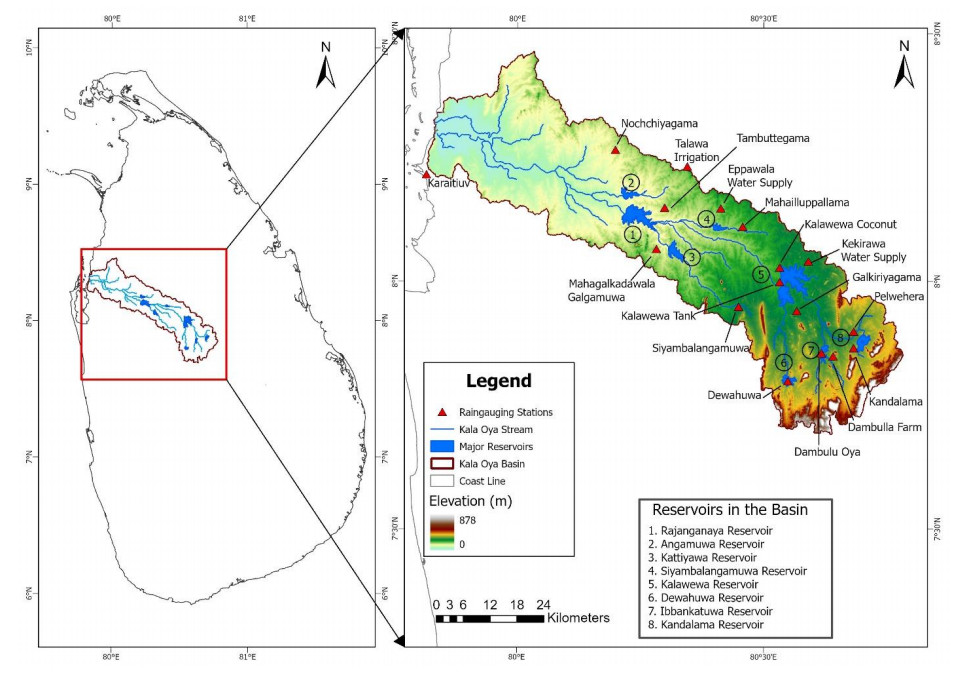









 DownLoad:
DownLoad:
